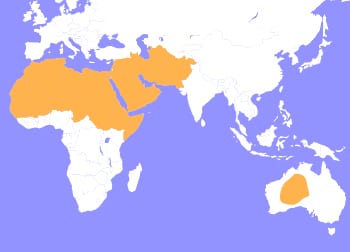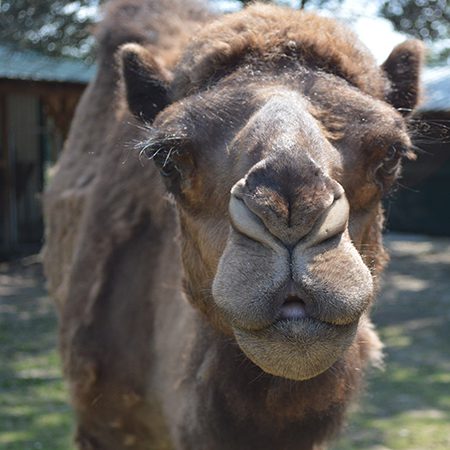Dromedary Camel
Camelus dromedarius
The Dromedary Camel is also known as the Arabian camel, an even-toed ungulate (hoofed animal) with one hump on its back. Dromedary camels are the tallest of the three species of camel; with adult males standing up to 6.5 ft. Dromedary camels are visually known for their distinctive curved neck, narrow chest, and single hump on its back. Their coats are typically a sandy shade of brown.
Contrary to popular belief, a camel's hump is made of fat, not water. This provides lots of energy when food is scarce. Camels are mainly diurnal and active during daytime hours, free-ranging herds feed and roam throughout the day; though they rest during the hottest hours around noon. They feed on foliage and desert vegetation, living in such harsh environments, they’ve also had to adapt in other ways. Having the ability to tolerate losing more than 30% of its total water content is one extreme example. Dromedary camels will typically form cohesive social groups to live in about 20 camels. The groups consist of several females, led by a dominant male, and their offspring. Males will likely introduce themselves into new groups or roam alone. Herds have been seen to congregate and form associations of hundreds of camels during migrations due to natural disasters.
Dromedary camels have not occurred naturally in the wild for nearly 2,000 years. It was first thought to be domesticated in Somalia or the Arabian Peninsula about 4,000 years ago. In the wild, the dromedary camel inhabited arid regions, including the sahara desert. Domesticated dromedary camels are found in arid regions of Africa and the Middle east. There is also a significant feral population occurring in Australia.

Since the 2000's Dromedary Camels have ranged from Northern Africa, to the Arabian Peninsula, and parts of Australia.
HABITAT -They inhabit dry arid regions, including the sahara desert.
DIET -They are herbivorous animals, eating primarily thorny plants, dry grasses, and saltbrush.
FUN FACT -The dromedary camel is capable of drinking 100 L (30 gal.) of water in just 10 minutes.
SOCIAL BEHAVIOR -They will form social groups of up to 20 camels, and are domesticated.
ACTIVITY -They are diurnal, meaning they are active during the daytime and sleep at night
PREDATORS -Although not common in the wild, predators would include lions and leopards.
SIZE -Both males and females can reach 6 feet tall, weighing between 650 - 1300 lbs.
RELATIVES -There are three different species of camel all related, with hybrids being bred with the different species.
CONSERVATION -Dromedary camels are extinct in the wild and exist only in domestic and feral populations..
Cub Creek Animal Care Information
Housing - Our dromedary camel lives in a large open pasture environment, with sections of it being dry arid dusty and others with lush grasses and trees. He loves rolling around in the dirt on a hot summer day. There is also a covered portion of the enclosure to provide shelter, which is fenced in to keep potential predators out. We provide automatic water dispensers that always keep fresh water available. This enclosure is multi species, our Dromedary camel sometimes lives with miniature horses, zebu, and emu!
Diet - We feed our dromedary camel a mixture of different dry foods to provide him with all the nutrition he needs! We give him a large mixture of allstock and rabbit pellets, and he always has hay to snack on. He will graze on the grassy parts of the pasture, eating small foliage. He also enjoys special treats such as fruits, and vegetables, (his favorite is a whole apple!).
Enrichment - Our dromedary camel was bottle raised by the owners of camp and as a result loves spending time with his handlers, campers, and anyone else who stops by. He lives in a multi-species pasture where he gets plenty of exercise grazing and roaming. He's also been given a pasture ball which he kicks around with glee! His favorite enrichment comes in the form of greeting every visitor to the pastures and following them around as they go (especially if they have treats for him!).


